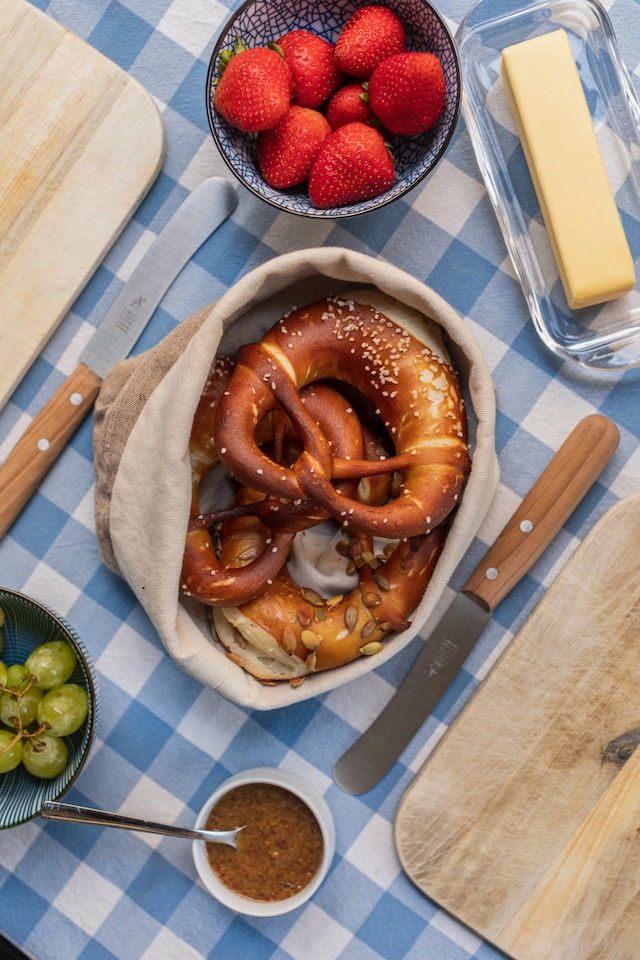Cuisine

Bridge to Germany:
German cuisine is known for its hearty and flavorful dishes that reflect the country’s rich culinary traditions. Here are some key points about German cuisine:
- Meat and Sausages: German cuisine is often associated with meat, particularly pork. Popular dishes include bratwurst, schnitzel (breaded and fried meat cutlets), and sauerbraten (marinated pot roast). Sausages, such as the famous currywurst and various regional specialties like Nürnberger Rostbratwurst, are also widely enjoyed.
- Potatoes are a staple in German cuisine and feature in many dishes. From boiled and mashed potatoes to potato dumplings (kartoffelknödel) and potato pancakes (Kartoffelpuffer), they are a versatile ingredient.
- Bread and Pretzels: Germany is known for its bread culture, with various bread types available, from hearty rye bread to crusty rolls. Soft pretzels (Brezeln) are another popular German snack, often enjoyed with mustard.
- Sauerkraut and Pickled Foods: Fermented cabbage, known as sauerkraut, is a common accompaniment to many German dishes, adding a tangy flavor. Pickled cucumbers and other vegetables are also commonly enjoyed.
- Cabbage Dishes: Cabbage plays a significant role in German cuisine. Dishes like cabbage rolls (Kohlrouladen), red cabbage (Rotkohl), and cabbage stew (Krautsuppe) are popular, particularly during the colder months.
- Dairy Products: Germany produces a wide range of dairy products. Cheese, such as the famous Emmental, Limburger, and Camembert, is widely enjoyed. Quark, a type of creamy cheese, is often used in desserts and spreads.
- Cakes and Pastries: German baking is renowned for its delicious cakes and pastries. Classics include Black Forest cake (Schwarzwälder Kirschtorte), apple strudel (Apfelstrudel), and bee sting cake (Bienenstich).
- Beer and Wines: Germany has a long brewing tradition, and beer is a significant part of German culture. The country produces a wide range of beer styles, including lagers, wheat beers, and pilsners. Wine production, particularly white wines like Riesling, is prominent in certain regions.
- Regional Specialties: Germany’s cuisine varies across its regions, with each area having its specialties. Examples include Bavarian cuisine with its pretzels, sausages, and beer, Swabian cuisine with dishes like spätzle and Maultaschen, and the seafood-focused cuisine of the North Sea and Baltic coast.
German cuisine combines hearty ingredients, traditional cooking techniques, and rich flavors. It has influenced many dishes and culinary traditions across Europe and continues to be celebrated for its comforting and satisfying nature.

Written by Melissa Dietrich
More From This Category

Memories in a Winter Wonderland
Memories in a Winter Wonderland Winter in Germany is absolutely magical, and for visitors, it’s a family-friendly season packed with unique activities, heartwarming traditions, and plenty of holiday cheer. Memorable experiences of a winter adventure in Germany are...

Driving In Germany
A Quick Guide to Surviving the Autobahn and More Driving in Germany can be quite the experience. Scenic views, orderly rules, and the fabled Autobahn (pronounced "ah-uu-toh-baan"). But before you hit the gas, there are many essential road rules to maintain harmony for...

Shopping For Fresh
Shopping habits in Germany


0 Comments